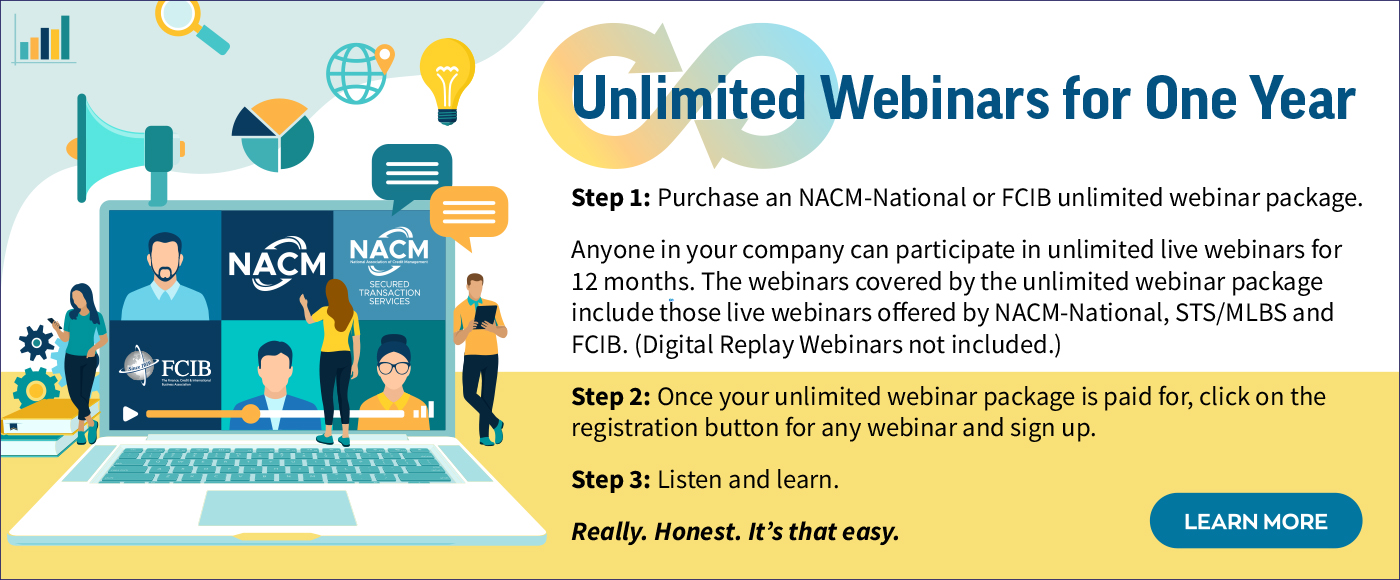eNews February 25
In the News
February 25, 2021
No Warnings of a Fed Shift
Chris Kuehl, Ph.D., NACM Economist
The subject of inflation has not been part of the conversation for a couple of decades. The last time the rate of inflation was consistently over the 2.0% target set by the Federal Reserve was in the early 1990s—almost nothing has suggested that it was headed up since.
In the last couple of months, the fears of an inflation surge have emerged, but it is still a bit confusing as to why. The logic is as follows. The Biden administration is pushing for a massive $1.9 trillion stimulus package, which is coming at the same time the economy has started to show some definite signs of recovery. This big flood of cash would combine with that growth to cause overheating and inflation sufficient to trigger the Fed to end its easy money policies. There would be interest rate hikes, and there would be reduced bond purchases. These moves would slow the economy down (as they are intended to do).
The problem with this line of thinking is that there is not much else pointing to an inflation surge; and judging by the comments made by Fed Chair Jerome Powell before Congress, there is no desire to impose limits on the recovery by reversing the policies that have been in place for the better part of the last decade.
Certainly, there is a reason to worry about potential inflation threats. Of the three prime motivators for an outbreak, one is manifesting right now; the second could potentially develop with the stimulus; and only the third seems to be under control.
The wage inflation part of this equation is not a factor and is unlikely to become one any time soon. For one thing, tens of millions of people are still without jobs; that holds wages and salaries down. More importantly, wage inflation is not manifesting when the rate of unemployment was as low as 3.5%. According to the Philips Curve, there should have been. The primary reason for the continued lower wage rates is globalization. If there is a sharp demand for higher wages in a given country, the option of moving operations to a place where the wages and other costs are lower always exists. This leaves the other two planks as far as inflation is concerned.
The commodity pressure has started to become evident as metal prices rise along with lumber and other raw materials. The most important commodity driver is usually oil, and these prices have been going up as well. The question is how high these prices will rise and what is actually motivating the rise. Oil is a good example because it has been pushing into the $60 a barrel range after languishing in the $40s and low $50s for the last couple of years. Has there been a major supply issue? Not so far.
The U.S. continues to supply most of the oil it requires and is not as sensitive to production interruption in other nations. Is there are surge in demand? Not a long term one at this point. The deep freeze boosted demand for all manner of fuel, but these requirements will start to fade as the weather warms.
The demand from consumers has not recovered and will not as long as millions continue to work from home. The majority of oil analysts assert that prices will be back to the $40s and $50s for the bulk of the year and into next. It has been asserted that President Joe Biden’s climate change policies will put a major dent in oil and gas production, but thus far the approach seems to be to push alternate energy where feasible as opposed to banning the use of fossil fuel. The bottom line from an inflationary point of view is that it seems the commodity hikes seen thus far are temporary.
That leaves the money supply motivation. This all comes down to timing and the actions of the consumer. If the economy really starts to boom at the same time the stimulus arrives and the bulk of that stimulus is spent very aggressively by the consumer, a distinct possibility exists that money will start chasing money and inflation will be an issue.
The assertion made by Powell before Congress is that the economy is not in good shape right now despite the more promising data that has been emerging of late. The assumption is that most of the money allocated will be more rescue than stimulus. It will go to people who were savaged by the recession, and they are unlikely to engage in some kind of wild spending spree. They will be using the additional assistance to pay rent, mortgages and debt. The upper 25% of income earners are the ones who do the majority of the spending, and they are not slated to get much of this largesse. Again, the bottom line is that Powell is not talking about an inflation threat and is not talking about any sort of tightening in money policy.
Stepping into Leadership: Continuing Education
with NACM’s Certification Programs
Andrew Michaels, editorial associate
American author and business consultant, Ken Blanchard said, “All leaders are permanent learners.” Many leadership experts like Blanchard have shared similar sentiments about why leaders must continue to educate themselves in their respective industries.
In the business credit profession, college courses on the subject are sparse. Although experience is an excellent teacher, several credit professionals said completing NACM’s professional certification programs has not only improved their understanding of credit, but also has opened up new opportunities to become leaders in the credit department.
The certification process begins with the NACM National education department, which tracks progress, including courses completed and designations earned. NACM offers four levels of certification, which build off of each other:
- Credit Business Associate (CBA) is an academic-based designation, which signifies mastery of three business credit disciplines: Basic Accounting, Business Credit Principles and Introductory Financial Statement Analysis.
- Credit Business Fellow (CBF) is earned after the CBA and is an academic- and participation-based designation, which affirms recipients understand and contribute to the field of business credit. Courses include Business Law and Credit Law.
- Certified Credit Risk Analyst (CCRA) is also an academic-based designation, which signifies mastery in the analysis and interpretation of financial statements and the ability to make informed credit risk assessments.
- Certified Credit Executive (CCE) is NACM’s highest designation and substantiates mastery of the credit function at an executive level. Candidates must pass a rigorous exam that tests their knowledge in the areas of accounting, finance, domestic and international credit concepts, management and law. Holders of a CCE designation must recertify every three years, further endorsing their commitment to continuing education, self-improvement and advancement in the business credit profession.
International designations are comprised of the Certified International Credit Professional (CICP) and the top-level International Certified Credit Executive (ICCE). To earn the CICP, candidates must successfully complete the International Credit & Risk Management online course and exam.
“A designation indicates a commitment and passion for the profession,” said Ed Bell, CBA, CICP, ICCE, senior manager for Grainger’s credit administration. “It also indicates you have been properly trained in the principles of credit, which are not really taught in college courses.”
In the year and a half, it took him to earn his designations, Bell proved to his company how beneficial they were to his department and he eventually made NACM designations a requisite for his staff.
The effective management of company resources, specifically credit, is essential for a company to remain viable, Bell said. Credit education has earned him respect from peers and leadership within the company as well as a leadership role, he added. The knowledge he and the others in his credit department gained through credentialing has improved performance in the department and strengthened the relationship with other departments and senior leaders.
In addition to respect, Richard Worden, CBA, CBF, CCE, senior manager of credit and collections at Sidley Austin LLP, noted his designations have earned him trust from his internal and external clients.
“My designations have created opportunities for connection, and my supervisors have grown to trust my judgment and expertise,” Worden said. “I once had a situation where I searched for a new position, and I had an offer within two business days of my interview. The certification was important and the company agreed to financially maintain it.”
Becoming a leader means investing in yourself. Attaining designations means spending weeknights and weekends studying and completing homework, but it’s worth it, said Wendy Mode, CCE, CICIP, corporate credit manager for ROMCO Equipment Co. For example, several of her employers accepted her CCE designation in lieu of a bachelor’s degree, even preferring it because of its focus on credit management and the accompanying responsibilities.
“I was highly encouraged to get my credentials in order to learn more and become active in the NACM community,” Mode said. “Not only the education and learning, but the networking would provide far greater benefits than ever imagined.”
For more information on NACM’s Certification Programs, go to https://nacm.org/certification.html.
 |
|
Successful leaders know how to increase their contributions by working through others. Studies show that 83% of leaders are underperforming. Join Winthrop Jeanfreau and learn how to go from being an individual contributor to an effective leader. In addition, he’ll share how to increase your ability to accomplish more as you take on more responsibility. Topics include:
|
Extreme Weather Has Texas Contractors Pressing Pause
on Projects
Bryan Mason, editorial associate
It appears everything is bigger in Texas—even its temperature extremes. A recent barrage of winter weather has Texan contractors shutting down their construction sites across the state.
The temporary shutdowns are not only the result of snow and ice accumulation, but the uncharacteristic drop in temperature and loss of power. Many contractors are taking precautions to protect their workers as well, referencing the dangers that come from having their workers travel on the roads.
However, these delays may come with repercussions because many of these projects could experience cost increases, loss in productivity, damage costs and more.
“Contractors really need to read their contracts to determine which contract clauses apply to the many layers of disruption and increased costs that resulted from the weather and related outages,” said Jason Walker, shareholder and director of litigation with Andrews Myers in Houston. “Many contracts only provide for time extensions to the construction schedule in the event of a weather-related delay, not compensation for lost time or productivity.”
So, although these delays have already made an immediate impact, contractors may see themselves running into legal issues with their properties.
“There are some narrow ‘common law’ theories that may fill in some of the gaps when the parties’ written contract either doesn’t speak to a particular situation or delay, or is vague and ambiguous,” Walker said.
Although most construction agreements allow for built-in extensions due to the possibility of extreme weather, that doesn’t exclude the possibility of damaging ripple effects.
Chris Ring, of NACM’s Secured Transaction Services (STS), points to the disruption in the general flow of cash. With many of our members being material suppliers on projects, there’s a chance that future issues may arise, Ring said. “Most of our members sell to subcontractors. So, the property owner pays the general contractor; the general contractor pays the subcontractor; and then the subcontractor pays our material supplier members.”
This news becomes even more concerning when you consider the exponential rise in steel and lumber costs, which could slow construction jobs even more, according to Construction Dive. With steel and lumber being two primary building materials, contractors may have more than just poor weather conditions to overcome.
Construction Dive reports that over the past year, softwood lumber prices surged 73%, according to the Producer Price Index. For iron and steel scraps, there was a 50.8% upswing during that time, including a 20.6% rise from December to January.
In the Austin American-Statesman, Vaike O’Grady, regional director for Zonda states, “The delays come at a particularly hard time because we are so behind in adding to desperately needed supply."
“Bad weather is always tough on the homebuilding industry," said O'Grady. "In this case, we're dealing with never-before-seen temperatures that will no doubt cause widespread damage. Unfortunately, most job sites will have had to shut down. That means delays in new home starts as well as challenges in homes getting completed for home buyers."
Despite the possibility of potential financial heartache, contracting companies like AECOM and DPR don’t plan on opening until it’s safe for workers to be on the job site. Both AECOM and DPR have used emergency measures that were set in place and look to protect the wellbeing of their workers.
“Right now, we’re trying to stay in touch with our employees and make sure they’re safe,” said Matt Hoglund, regional manager with DPR Construction, per Construction Dive. “That’s what’s most important.”
For all of the talk of accelerated digitization and modernization of the enterprise over the past year, corporates still face plenty of friction in their business-to-business (B2B) payment workflows. These pain points lurk anywhere in the payment cycle, impacting buyer-supplier relationships, reconciliation, cash allocation and everything in between.
At the heart of many of those challenges is data. PYMNTS and Flywire have collaborated on a new research report, Payments 2021: Assessing The Digital Gaps In Business Payment Flows. More than one-fifth of decisionmakers surveyed at technology firms, education institutions and travel companies identify a lack of access to real-time data as a major source of friction in their own payment operations. That lack of access to data is exacerbating other challenges, from managing vendor relationships to reconciling receivables.
Yet there is plenty of technology available from financial service providers today eager to transform B2B payments for corporate customers. So, what’s holding back organizations from adopting these tools and alleviating their own payment pains?
Ryan Frere, executive vice president and general manager of B2B at Flywire, points to the tendency of the commercial payments space—and of corporates themselves—to take an inefficient route to payments optimization.
“It’s complicated, and it doesn’t need to be,” he told Karen Webster. “And as a result of it being so complicated, companies feel they have to get payment expertise and build up the payments function internally, just to manage payment service provider vendor relationships.”
A History of Complexity
Ironically, Frere said he often sees corporates attempting to ease the complexity of managing vendor relationships by working with more payment service providers. It’s a baffling tactic that has its roots in the business-to-consumer (B2C) payments technology landscape. Historically, companies had been forced to adopt multiple solutions and platforms to be able to accept a variety of payment methods and loop into various payment rails.
The result was not only a multitude of payment vendors those firms had to manage, but also a back-office infrastructure of disparate platforms that were unable to interconnect and failed to provide real-time data visibility. It’s a pattern that may be repeating in the B2B payments landscape as more solution providers introduce new products to the market that vow to tackle different pain points.
“Everybody’s stuck in this layer of managing those relationships, managing their own payment operations, as opposed to taking a step up and asking, ‘Is there a way for us to solve this through software?’” said Frere.
Just as Stripe began to consolidate the way businesses consume B2C payment technology, other software vendors are introducing solutions that not only address individual pain points of high value B2B transactions like reconciliation or card acceptance, but to streamline the entire B2B payment ecosystem so that businesses no longer have to tackle each pain point one by one.
As Frere explained, this value proposition isn’t about alleviating pain points, it’s about removing them from the equation altogether with technology that can provide the necessary payments functionality and enhance automation, compliance and real-time data visibility. For example, rather than figuring out which local vendor to use to support cross-border transactions from a new jurisdiction, businesses can adopt software that handles that process for them and use those resources instead to actually invest in that global growth.
Expanding the Focal Point
Although organizations have long expressed frustration from various disruptions within the accounts payable (AP) department, the survey conducted by PYMNTS and Flywire revealed nearly one-quarter of respondents are concerned with the struggle of supplier management. It’s a revelation that has broader implications for the strategies that organizations deploy when modernizing their B2B payment workflows, with the vendor relationships becoming a more important factor in the process.
“If you look at the way the industry has developed over the years, it has been a lot of focus on AP,” noted Frere. “But the biller really begins the conversation of how to get paid, so it’s really important that the biller is taken into consideration.”
Expanding the focus to include accounts receivable (AR) points of friction can help guide organizations (and their service providers) in how to elevate the payments experience for everyone involved. After all, a supplier waiting 75 days to get paid isn’t simply facing a cash flow bottleneck. They’re also exposed to foreign exchange (FX) fluctuations, the potential for failed transactions, and other risks, resulting in a high volume of yearly write-offs.
In addition to potentially accelerating payment to suppliers, B2B payments modernization initiatives can improve cash flow predictability by boosting the availability of real-time data for both sides of the equation. Data is also critical to ensuring that a supplier receiving payment can apply that cash to the appropriate invoice, Frere said.
Once again, easing pain for both buyer and supplier is another opportunity for corporates to consolidate their service provider base and choose payment technologies that can play double-duty. Software that can facilitate automated reconciliation across payment rails, for instance, and inject significant efficiency within the AR department.
At the end of the day, said Frere, the ability to move the needle on optimizing B2B payments is all about dollars and cents. Calculating a clear return on investment (ROI) on payments technology investment is key for corporates and their suppliers, and as businesses accelerate their efforts to digitize, removing costs will be a top priority. Demonstrating how a cost-cutting tool can then remove complexity is typically the tipping point for finance leaders when choosing the right tools.
“When you talk about what companies are looking to do, you can digitize payment flows in a way that really starts to provide a benefit,” said Frere. “You’ve removed massive complexity that people didn’t think was possible.”
Reprinted with permission from PYMNTS.com.
|
Upcoming Webinars |
|
Mar 4 |
How to Lead
Speaker: Winthrop Jeanfreau |
| A Creative Approach to Accounts Receivable Insurance
Speakers: Ursula Wegrzynowicz and Jennifer Krause |
Mar 9 |
|
Mar 10 |
Critical Elements of the Mississippi Lien and Bond Statutes
Speaker: Chris Ring |







